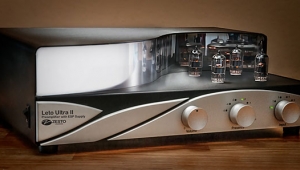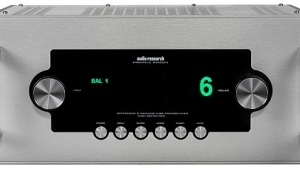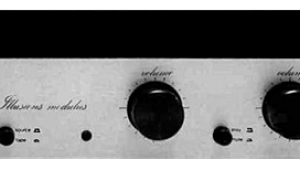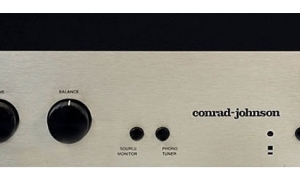| Columns Retired Columns & Blogs |
Hovland HP-100 preamplifier Page 2
I gazed admiringly at the HP-100's innards. Instead of spending the development years tacking on circuits in an effort to improve the sound, the Hovland design team clearly devoted itself to carving away superfluous clutter, just as an editor removes words to clean up copy. The layout looks so clean and simple. But, of course, looks can be deceiving. What goes on under the HP-100's hood is anything but.
Hovland says they chose a solid-state power supply for greater reliability, contending that tube rectifiers deteriorate sonically in a slow, insidious way. The HP-100's power supply doesn't rely on brute force, using only "modest filtering" via high-quality, specially built capacitors. The custom transformer is non-toroidal but features an oversized core for low heat production and low magnetic radiation. Nonetheless, it's positioned far away from the high-gain stage, as well as being separated from it by two internal metal walls.
The HP-100 uses glass epoxy boards mounted in secure but not rigid grommets of shock-absorbing urethane. Hovland tried spring dampers, but they seemed to detract from the sound. Parts quality is high: MusiCaps (duh!) are used throughout, along with Caddock and Holco resistors. Cabling is Hovland Generation 3 shielded silver interconnect. The hard-gold-plated RCA jacks are chassis-mounted, with collet-type pin sockets.
The 31-position (2dB steps), custom-made, low-mass, coin-silver-contact stereo volume control is configured as a series attenuator instead of the more conventional shunt configuration: the source sees a constant input impedance and the listener is "...not forced to listen through high-value resistors" at certain levels. The silver-contact input selector features "contact break before make," so two devices never "see" each other during the switching process. Unused inputs are not shorted, which means there might be slight bursts of hum and noise when switching between sources. Through listening tests, Hovland determined that the HP-100 sounded better this way.
Hovland is big on using long interconnects from preamp to amp and short speaker cables, so the line-stage output features a cathode-follower buffer, which, I was told, reduces impedance to less than 1000 ohms. (The spec sheet claims approximately 2600 ohms.) According to Hovland, the HP-100 is "happy" with different cables, and the sound doesn't change with cable length. Both the phono and line stage are non-inverting, and the preamp is single-ended.
While its design incorporates many custom parts, the heart of the HP-100—the tubes—are readily available, relatively inexpensive Sovteks. (Hovland requests that you not try to improve on them with vintage tubes or other brands.) The 14dB-gain line section uses a pair of 12AX7s and one 12AU7; the 46dB moving-magnet phono section, a pair of 12AX7s and one 12AT7. Tube life is said to be 2500 hours; matched replacement sets are available from Hovland.
MM/MC phono stage
The optional phono stage—mandatory for this analog lover—is available as a dealer-installed upgrade for $1095 (moving-magnet) and $1695 (moving-coil). MM owners wishing to step up at a later date will have to fork over an additional $695. Hovland says the phono circuit is "unusual, though it looks simple." RIAA equalization is not implemented as a passive filter in series between gain stages, as is done in many phono stages. Instead, it's applied via a "nested" feedback loop. The MM section provides 46dB of gain, which is enough for both MM and some medium- to high-output MC cartridges. Most phono enthusiasts will probably opt for the MC version: it includes a built-in step-up transformer, also available as a dealer-installed upgrade.
You're precluded from using an MM cartridge once the step-up is installed: Hovland believes a selector switch would degrade the sound. If you use both kinds of cartridges, the solution is to add an outboard MM phono section of your choice into an Aux input. Incidentally, instead of a 47k ohm input impedance, the MM stage is "loaded" at 1 megohm—almost no load at all—but Hovland feels the sound is better this way. After all, 47k ohm is an arbitrary standard. [I believe the standard 47k load impedance was chosen to work best with the relatively high inductance and source impedance of typical MM cartridges, though the various Shure V15s, if I remember correctly, needed 68k ohms.—Ed.]
The step-up transformer is built for Hovland to their specifications. It features copper wire, using, according to Hovland, "unique winding technologies" whose creation required many worker-hours of investigation into transformer design. The final approach yields a high degree of consistency in sound from unit to unit, according to the company. The step-up adds 20dB of gain, or 10 times voltage, for a total of 66dB of gain (including the MM section's 46dB), which should be enough for any MC cartridge. If your MC cartridge's output is up near 900µV, you won't need or want the step-up transformer option.
The load the cartridge sees with the MC step-up is around 450 ohms (similar to AR's Reference Phono stage MC input), which Hovland finds works well with most MC cartridges. Should you wish to load down further, there are provisions for adding resistors, but Hovland feels that most modern MCs don't need them.
- Log in or register to post comments




































